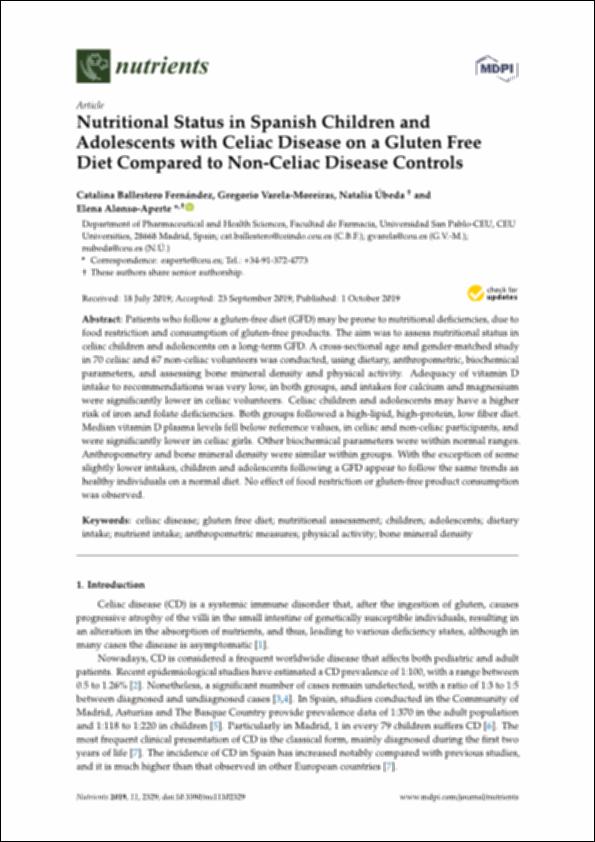Please use this identifier to cite or link to this item:
http://hdl.handle.net/10637/15036Nutritional Status in Spanish Children and Adolescents with Celiac Disease on a Gluten Free Diet Compared to Non-Celiac Disease Controls
| Title: | Nutritional Status in Spanish Children and Adolescents with Celiac Disease on a Gluten Free Diet Compared to Non-Celiac Disease Controls |
| Authors : | Ballestero Fernández, Catalina Varela Moreiras, Gregorio Úbeda Martín, Natalia Alonso Aperte, Elena |
| Keywords: | Celiac disease; Gluten free diet; Nutritional assessment; Children; Adolescents; Dietary intake; Nutrient intake; Anthropometric measures; Physical activity; Bone mineral density |
| Publisher: | MDPI |
| Citation: | Ballestero Fernández C, Varela-Moreiras G, Úbeda N, Alonso-Aperte E. Nutritional Status in Spanish Children and Adolescents with Celiac Disease on a Gluten Free Diet Compared to Non-Celiac Disease Controls. Nutrients. 2019 Oct 1;11(10):2329. doi: 10.3390/nu11102329 |
| Abstract: | Patients who follow a gluten-free diet (GFD) may be prone to nutritional deficiencies, due to food restriction and consumption of gluten-free products. The aim was to assess nutritional status in celiac children and adolescents on a long-term GFD. A cross-sectional age and gender-matched study in 70 celiac and 67 non-celiac volunteers was conducted, using dietary, anthropometric, biochemical parameters, and assessing bone mineral density and physical activity. Adequacy of vitamin D intake to recommendations was very low, in both groups, and intakes for calcium and magnesium were significantly lower in celiac volunteers. Celiac children and adolescents may have a higher risk of iron and folate deficiencies. Both groups followed a high-lipid, high-protein, low fiber diet. Median vitamin D plasma levels fell below reference values, in celiac and non-celiac participants, and were significantly lower in celiac girls. Other biochemical parameters were within normal ranges. Anthropometry and bone mineral density were similar within groups. With the exception of some slightly lower intakes, children and adolescents following a GFD appear to follow the same trends as healthy individuals on a normal diet. No e_ect of food restriction or gluten-free product consumption was observed. |
| URI: | http://hdl.handle.net/10637/15036 |
| Rights : | http://creativecommons.org/licenses/by-nc-nd/4.0/deed.es |
| ISSN: | 2072-6643 |
| Issue Date: | 1-Oct-2019 |
| Center : | Universidad San Pablo-CEU |
| Appears in Collections: | Facultad de Farmacia |
Items in DSpace are protected by copyright, with all rights reserved, unless otherwise indicated.


